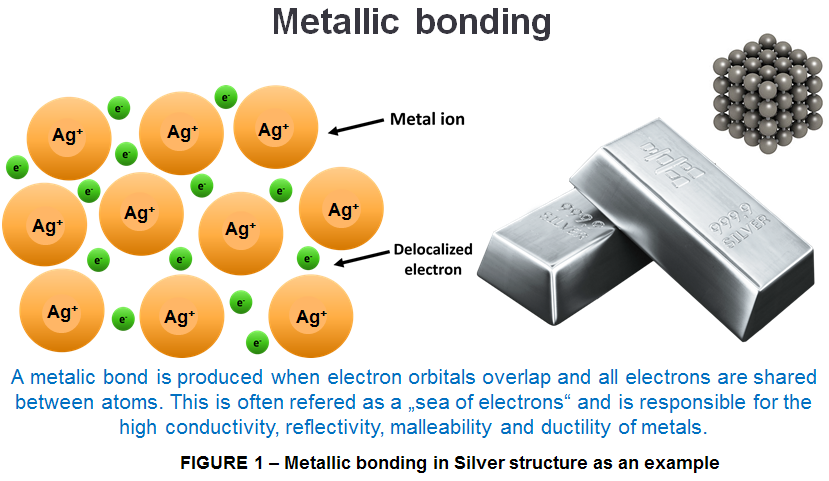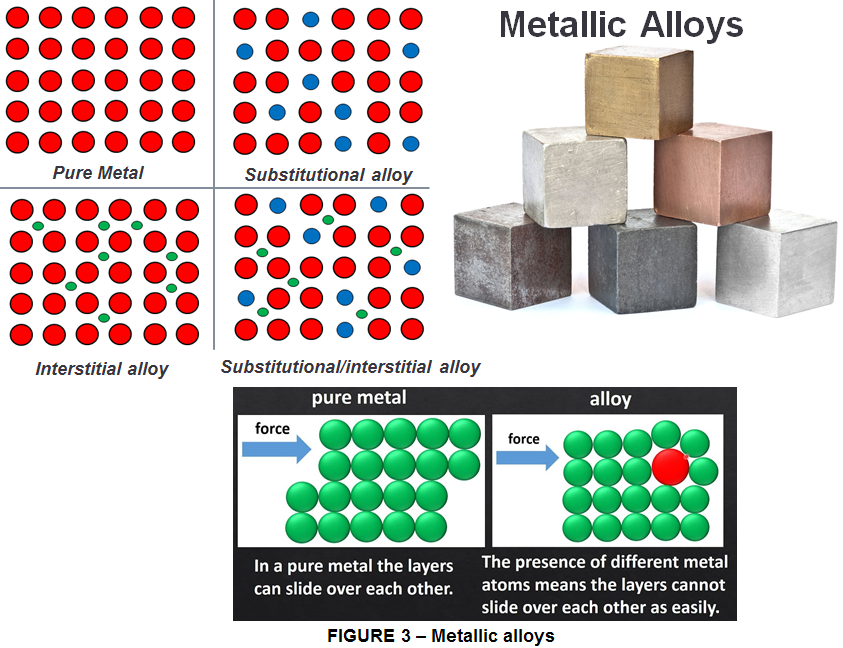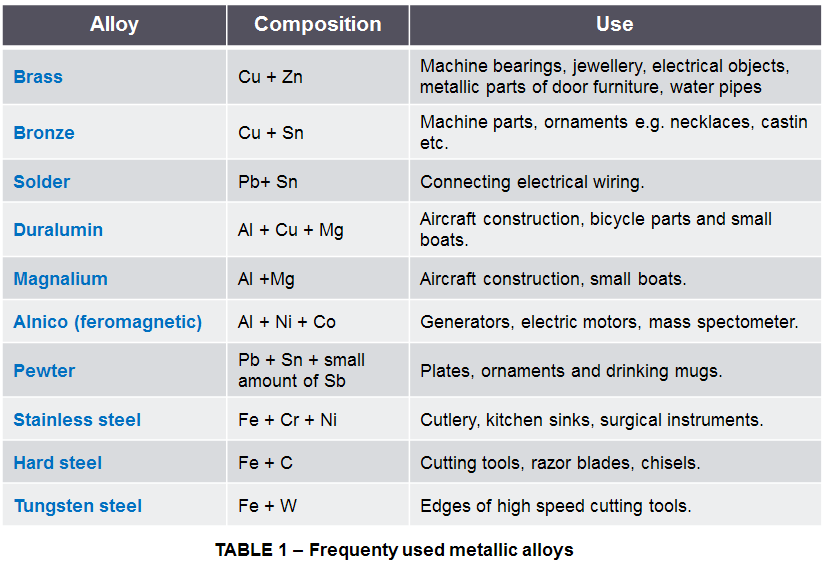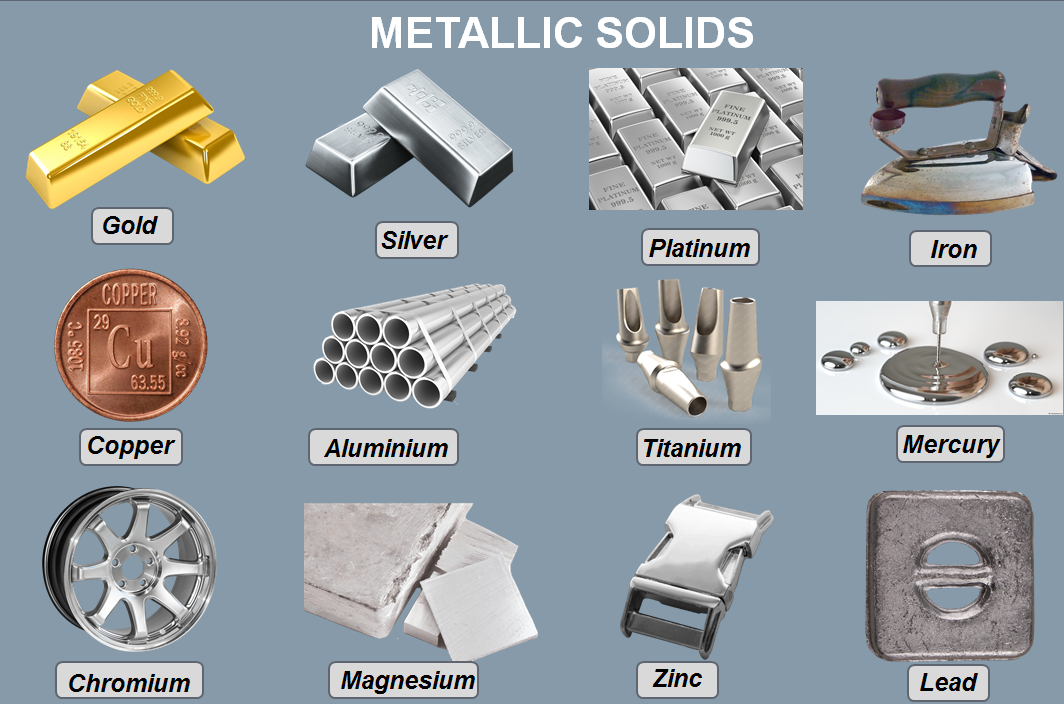Here we talk about the most common type of solids. These are the ones which we use them on daily basis. If you stop for a second and look around you, you will notice that most of the objects that you have are either made up of metals or contains a metal. For example, your watch has metal components, and your cooking pan too. Your car, your computer are mostly made of metallic components. If you have a piece of jewelry made up of pure silver or gold, you have a metallic solid in your hands! So let’s explore a little bit this type of solids.
WHAT IS A METALLIC SOLID?
A Metallic solid is = a substance in which the particles are linked through a lattice of metallic bonds composed of positive ions (cations) that are attracted to each other in a cloud of delocalized electrons. Within this cloud the electrons can move freely between atoms.
Metallic solids are exactly what their name suggests: a solid made up of metal atoms only. Think of it like a “metals only” exclusive club. You can only be a member of this club if you are made entirely of metal atoms!

When dealing with solids we must always consider that this can be either crystalline (which is a well-organized 3D structure) or amorphous (disordered structure) solids. Metallic solids mostly occurs as crystalline solids, but under a controlled process of temperature (rapidly heated, then rapidly cooled) and pressure, metallic solids in amorphous version can also be obtained. These are often called metallic “glasses”.
We can describe elements as being good or poor metals depending on their metallic character, and the more an element exhibits the properties of metals, then the more metallic that element is. In the periodic table, metallic characters tend to increase from right to left, and down a group. Kind of like electronegativity, if you remember (been talking about this in my other articles about Solid State of Matter).
Metallic bonds are nondirectional, meaning that metal atoms can remain bonded while they roll against each other as long as some parts of their surfaces are in contact. These unique properties of metallic bonds are largely responsible for some of the valuable behavior of metals, including their conductivity and maleability.
EXAMPLES OF METALLIC SOLIDS.
Quarters of the known elements are metals and except for mercury (Hg), all metals are solids at room temperature.

As Periodic table shows we have metallic solids as:
- Group I of metals known as the alkali metals (Li, Na, K, Rb, Cs, Fr).
- Group II of metals are called the alkaline earth metals (Be, Mg, Ca, Sr, Ba, Ra)
- Groups 3-12 contain many transition metals such as Fe, Cu, Ag, and Au.
- Group 13-16 also have some metals called post-transition metals or poor metals (Al, Ga, In, Tl, Pb, Sn, Bi, and Po).
PROPERTIES OF METALLIC SOLIDS.
MELTING POINT: When you melt a crystalline solid, its crystal lattice gets broken down and the molecules change into a liquid state. The melting point is the temperature at which a solid turns into a liquid. When a solid reaches its melting point, the temperature then remains constant until the crystalline solid completely melts and becomes a liquid! In case of metallic solids there is a diversity of melting points.
Although metallic solids usually have high melting points, some of them, such as the alkali metals (group 1), actually have low melting points. Metallic solids have melting points that are distinct to each metal.
In the group of transition metals for instance Tungsten has one of the highest melting points known by chemists. The melting point of a body-centered cubic lattice of Tungsten is around 3400 °C. While another metal, namely mercury (Hg) is already a liquid at -38 °C. Also, you can find basically anything in between among metallic solids Aluminum (Al) is a metal found in group 13 (also called III-A in some periodic tables). It has a high melting point of 660°C and has a face-centered cubic crystal lattice structure. Potassium (K) is a group 1 metal and has a melting point of 63.38 °C.
ELECTRICAL CONDUCTIVITY: is referred to as the ability to conduct electricity. Metallic solids are good conductors of electricity because of their delocalized electrons which are able to freely move and transmit electrical charges. Electricity is essentially a flow of electrons from one place to another, and in metallic bonds the outer electrons are relatively free to move between adjacent atoms. This electron mobility means it is easy for an electrical current to move from one end of a piece of metal to the other. When an electron is introduced at one end of a piece of wire by an electric current, this causes electrons to move from one to another metal atom continuously down the wire, allowing the current to flow.
THERMAL CONDUCTIVITY: is referred to as the ability to transfer heat. Metallic solids do this very well too. For a solid to conduct heat, the movement of one molecule or atom needs to be easily transferrable to its neighbor. The non-directional nature of the metallic bond makes this type of transfer relatively easy, so metals conduct heat well. The ability of metallic solids to conduct heat is the reason why most cooking utensils in your kitchen are made up of some type of metal because their delocalized electrons can acquire and transfer the heat from the stove or oven faster and then pass it on to the food that’s being cooked!
A very interesting experiment performed by scientists showed that if you add a droplet of a Sodium (Na) and Potassium (K) mixture to water (H2O), then water will turn into a metallic material with a golden color! This happens because it will borrow the outermost electron from both group 1 metals.
DUCTILITY & MALLEABILITY: Metallic solids are considered malleable and ductile and also many being very hard and stong in the same time. A malleable metal is a metal that can be battered into thin sheets. A ductile metal is a metal that can be molded into different shapes (like a wire) without breaking.
For instance why copper (Cu) is a great choice of metal to make electrical wiring, is exaclty because of the ability of copper to conduct electricity and because copper is ductile and can be molded into the shape of a wire.
As another example, gold (Au) can be hammered into thin gold leaves that are widely used in decorations. And, if that is not interesting enough, you can now even buy gold leaf flakes to use next time you cook your favorite dish!
Metallic maleability and ductility are a crucial reason that metals are so useful. Their electrical conductivity would be much less useful if it weren’t possible to stretch them into wires that could then be bent and shaped at room temperature for an incredible array of applications. They also create some drawbacks though. Metal jewelry can be crushed and deformed in the bottom of a purse, or a metal figurine can be dented if it’s dropped. Manufacturers must consider all the properties of the materials they plan to work with to find the best option for each application.
SOLUBILITY: Melting is one way of changing a solid’s shape. Another approach is dissolving the solid into some type of liquid, in this case referred to as a solvent. The extent to which a solid dissolves in a particular solvent is called its solubility. Solids can be dissolved into a variety of types of solvents, but for now we will focus on solubility in water. Dissolving a metal requires breaking metallic bonds, these types of bonds are very strong and hard to break. Therefore, metals are generally not soluble in water.
DENSITY: defined as the amount of mass that exists in a certain volume, is another important property that depends on the solid’s structure and composition. For example, metallic solids do not all share a similar arrangement of atoms. The ions in a metal lattice are closely packed, this giving the metals a High density, as there is little empty space between the atoms. However the atoms and molecules that make up crystals can pack in many different ways, which affects density. Therefore the density of the metal atoms depends upon the mass of the metal ions, their radius and how they are packed together. For instance Lithium, which is the least dense metal at 0.534 g/cm3, is an example of a Low density metal.
LUSTER : Metals are lustrous (shiny) because the delocalized electrons can reflect off the light! it all comes down to the delocalized electrons the metallic solids have in their structure.
METALLIC ALLOYS
When you combine different metals together, you create a metallic alloy that is also a solid which has metallic bonding. An alloy is referred to as a substance that is made up of a mixture of elements and has metallic properties. Alloys can be either interstitial or substitutional / or a mix of both (Fig. 3).

Interstitial alloys are alloys that form between elements of different radii. These alloys have a more rigid lattice, are less ductile, and are also less malleable compared to metallic solids. A common example of an interstitial alloy is steel, which is made up of carbon and metal ions of Iron.
Substitutional alloys are alloys that form between metals of very similar radii. Because of the similar sizes, some of the metal atoms initially present get replaced by another metal atom. A common example of a substitutional alloy is brass, which is made up of copper and zinc atoms. In brass, the copper atoms get replaced by zinc atoms.
Some of the most common examples of metallic alloys are presented in the Table 1.


Leave a comment